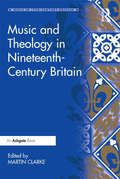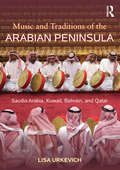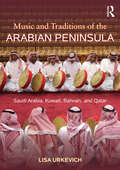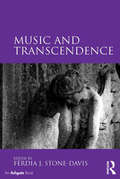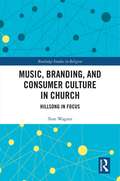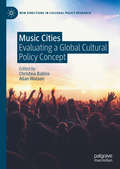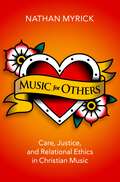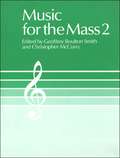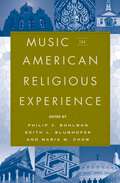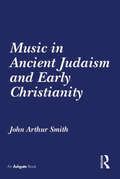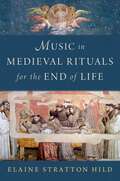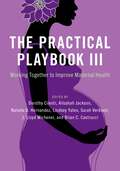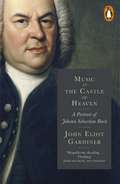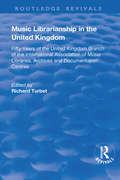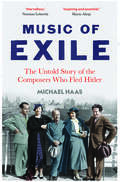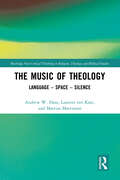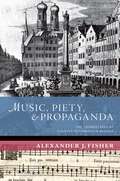- Table View
- List View
Music and Theology in Nineteenth-Century Britain (Music in Nineteenth-Century Britain)
by Martin ClarkeThe interrelationship of music and theology is a burgeoning area of scholarship in which conceptual issues have been explored by musicologists and theologians including Jeremy Begbie, Quentin Faulkner and Jon Michael Spencer. Their important work has opened up opportunities for focussed, critical studies of the ways in which music and theology can be seen to interact in specific repertoires, genres, and institutions as well as the work of particular composers, religious leaders and scholars. This collection of essays explores such areas in relation to the religious, musical and social history of nineteenth-century Britain. The book does not simply present a history of sacred music of the period, but examines the role of music in the diverse religious life of a century that encompassed the Oxford Movement, Catholic Emancipation, religious revivals involving many different denominations, the production of several landmark hymnals and greater legal recognition for religions other than Christianity. The book therefore provides a valuable guide to the music of this complex historical period.
Music and Theology in Nineteenth-Century Britain (Music in Nineteenth-Century Britain)
by Martin V. ClarkeThe interrelationship of music and theology is a burgeoning area of scholarship in which conceptual issues have been explored by musicologists and theologians including Jeremy Begbie, Quentin Faulkner and Jon Michael Spencer. Their important work has opened up opportunities for focussed, critical studies of the ways in which music and theology can be seen to interact in specific repertoires, genres, and institutions as well as the work of particular composers, religious leaders and scholars. This collection of essays explores such areas in relation to the religious, musical and social history of nineteenth-century Britain. The book does not simply present a history of sacred music of the period, but examines the role of music in the diverse religious life of a century that encompassed the Oxford Movement, Catholic Emancipation, religious revivals involving many different denominations, the production of several landmark hymnals and greater legal recognition for religions other than Christianity. The book therefore provides a valuable guide to the music of this complex historical period.
Music and Traditions of the Arabian Peninsula: Saudi Arabia, Kuwait, Bahrain, and Qatar
by Lisa UrkevichMusic and Traditions of the Arabian Peninsula provides a pioneering overview of folk and traditional urban music, along with dance and rituals, of Saudi Arabia and the Upper Gulf States of Kuwait, Bahrain, and Qatar. The nineteen chapters introduce variegated regions and subcultures and their rich and dynamic musical arts, many of which heretofore have been unknown beyond local communities. The book contains insightful descriptions of genres, instruments, poetry, and performance practices of the desert heartland (Najd), the Arabian/Persian Gulf shores, the great western cities including Makkah and Medinah, the southwestern mountains, and the hot Red Sea coast. Musical customs of distinctive groups such as Bedouin, seafarers, and regional women are explored. The book is packaged with an audio CD and almost 200 images including a full color photo essay, numerous music transcriptions, a glossary with over 400 specialized terms, and original Arabic script alongside key words to assist with further research. This book provides a much-needed introduction and organizational structure for the diverse and complex musical arts of the region.
Music and Traditions of the Arabian Peninsula: Saudi Arabia, Kuwait, Bahrain, and Qatar
by Lisa UrkevichMusic and Traditions of the Arabian Peninsula provides a pioneering overview of folk and traditional urban music, along with dance and rituals, of Saudi Arabia and the Upper Gulf States of Kuwait, Bahrain, and Qatar. The nineteen chapters introduce variegated regions and subcultures and their rich and dynamic musical arts, many of which heretofore have been unknown beyond local communities. The book contains insightful descriptions of genres, instruments, poetry, and performance practices of the desert heartland (Najd), the Arabian/Persian Gulf shores, the great western cities including Makkah and Medinah, the southwestern mountains, and the hot Red Sea coast. Musical customs of distinctive groups such as Bedouin, seafarers, and regional women are explored. The book is packaged with an audio CD and almost 200 images including a full color photo essay, numerous music transcriptions, a glossary with over 400 specialized terms, and original Arabic script alongside key words to assist with further research. This book provides a much-needed introduction and organizational structure for the diverse and complex musical arts of the region.
Music and Transcendence
by Ferdia J. Stone-DavisMusic and Transcendence explores the ways in which music relates to transcendence by bringing together the disciplines of musicology, philosophy and theology, thereby uncovering congruencies between them that have often been obscured. Music has the capacity to take one outside of oneself and place one in relation to that which is ’other’. This ’other’ can be conceived in an ’absolute’ sense, insofar as music can be thought to place the self in relation to a divine ’other’ beyond the human frame of existence. However, the ’other’ can equally well be conceived in an ’immanent’ (or secular) sense, as music is a human activity that relates to other cultural practices. Music here places the self in relation to other people and to the world more generally, shaping how the world is understood, without any reference to a God or gods. The book examines how music has not only played a significant role in many philosophical and theological accounts of the nature of existence and the self, but also provides a valuable resource for the creation of meaning on a day-to-day basis.
Music and Transcendence
by Ferdia J. Stone-DavisMusic and Transcendence explores the ways in which music relates to transcendence by bringing together the disciplines of musicology, philosophy and theology, thereby uncovering congruencies between them that have often been obscured. Music has the capacity to take one outside of oneself and place one in relation to that which is ’other’. This ’other’ can be conceived in an ’absolute’ sense, insofar as music can be thought to place the self in relation to a divine ’other’ beyond the human frame of existence. However, the ’other’ can equally well be conceived in an ’immanent’ (or secular) sense, as music is a human activity that relates to other cultural practices. Music here places the self in relation to other people and to the world more generally, shaping how the world is understood, without any reference to a God or gods. The book examines how music has not only played a significant role in many philosophical and theological accounts of the nature of existence and the self, but also provides a valuable resource for the creation of meaning on a day-to-day basis.
Music, Branding and Consumer Culture in Church: Hillsong in Focus (Routledge Studies in Religion)
by Tom WagnerStarting as a single congregation in Australia, Hillsong Church now has campuses worldwide, releases worship music that sells millions of albums and its ministers regularly appear in mainstream media. So, how has a single church gained such international prominence? This book offers an ethnographic exploration of the ways in which music and marketing have been utilised in the pursuit and production of spiritual experience for members of Hillsong Church. An experience that has proven to be incredibly popular. The main theme of this book is that marketing, specifically branding, is not just a way to "sell" religion, but rather an integral part of spiritual experience in consumer society. Focussing on the London Hillsong church as a case study, the use of its own music in tandem with strong branding is shown to be a co- and re-productive method of organizing, patterning, and communicating information. The church provides the branded material and cultural context in which participants’ sacred experience of self unfolds. However, this requires participants to "do the work" to properly understand, and ultimately embody, the values associated with the brand. This book raises important questions about the role of branding and music in forming modern scared identities. As such, it will be of great interest to scholars of Religious Studies, Ethnomusicology and Media Studies.
Music, Branding and Consumer Culture in Church: Hillsong in Focus (Routledge Studies in Religion)
by Tom WagnerStarting as a single congregation in Australia, Hillsong Church now has campuses worldwide, releases worship music that sells millions of albums and its ministers regularly appear in mainstream media. So, how has a single church gained such international prominence? This book offers an ethnographic exploration of the ways in which music and marketing have been utilised in the pursuit and production of spiritual experience for members of Hillsong Church. An experience that has proven to be incredibly popular. The main theme of this book is that marketing, specifically branding, is not just a way to "sell" religion, but rather an integral part of spiritual experience in consumer society. Focussing on the London Hillsong church as a case study, the use of its own music in tandem with strong branding is shown to be a co- and re-productive method of organizing, patterning, and communicating information. The church provides the branded material and cultural context in which participants’ sacred experience of self unfolds. However, this requires participants to "do the work" to properly understand, and ultimately embody, the values associated with the brand. This book raises important questions about the role of branding and music in forming modern scared identities. As such, it will be of great interest to scholars of Religious Studies, Ethnomusicology and Media Studies.
Music Cities: Evaluating a Global Cultural Policy Concept (New Directions in Cultural Policy Research)
by Allan Watson Christina BallicoThis book provides a critical academic evaluation of the ‘music city’ as a form of urban cultural policy that has been keenly adopted in policy circles across the globe, but which as yet has only been subject to limited empirical and conceptual interrogation. With a particular focus on heritage, planning, tourism and regulatory measures, this book explores how local geographical, social and economic contexts and particularities shape the nature of music city policies (or lack thereof) in particular cities. The book broadens academic interrogation of music cities to include cities as diverse as San Francisco, Liverpool, Chennai, Havana, San Juan, Birmingham and Southampton. Contributors include both academic and professional practitioners and, consequently, this book represents one of the most diverse attempts yet to critically engage with music cities as a global cultural policy concept.
Music for Others: Care, Justice, and Relational Ethics in Christian Music
by Nathan MyrickMusical activity is one of the most ubiquitous and highly valued forms of social interaction in North America (to say nothing of world over), being engaged from sporting events to political rallies, concerts to churches. Moreover, music's use as an affective agent for political and religious programs suggests that it has ethical significance. Indeed, many have said as much. It is surprising then that music's ethical significance remains one of the most undertheorized aspects of both moral philosophy and music scholarship. Music for Others: Care, Justice, and Relational Ethics in Christian Music fills part of this scholarly gap by focusing on the religious aspects of musical activity, particularly on the practices of Christian communities. Based on ethnomusicological fieldwork at three Protestant churches and a group of seminary students studying in an immersion course at South by Southwest (SXSW), and synthesizing theories of discourse, formation, and care ethics oriented towards restorative justice, it first argues that relationships are ontological for both human beings and musical activity. It further argues that musical meaning and emotion converge in human bodies such that music participates in personal and communal identity construction in affective ways-yet these constructions are not always just. Thus, considering these aspects of music's ways of being in the world, Music for Others finally argues that music is ethical when it preserves people in and restores people to just relationships with each other, and thereby with God.
Music for Others: Care, Justice, and Relational Ethics in Christian Music
by Nathan MyrickMusical activity is one of the most ubiquitous and highly valued forms of social interaction in North America (to say nothing of world over), being engaged from sporting events to political rallies, concerts to churches. Moreover, music's use as an affective agent for political and religious programs suggests that it has ethical significance. Indeed, many have said as much. It is surprising then that music's ethical significance remains one of the most undertheorized aspects of both moral philosophy and music scholarship. Music for Others: Care, Justice, and Relational Ethics in Christian Music fills part of this scholarly gap by focusing on the religious aspects of musical activity, particularly on the practices of Christian communities. Based on ethnomusicological fieldwork at three Protestant churches and a group of seminary students studying in an immersion course at South by Southwest (SXSW), and synthesizing theories of discourse, formation, and care ethics oriented towards restorative justice, it first argues that relationships are ontological for both human beings and musical activity. It further argues that musical meaning and emotion converge in human bodies such that music participates in personal and communal identity construction in affective ways-yet these constructions are not always just. Thus, considering these aspects of music's ways of being in the world, Music for Others finally argues that music is ethical when it preserves people in and restores people to just relationships with each other, and thereby with God.
Music for the Mass 2: Choir Edition
by Geoffrey Boulton Smith Christopher McCurryContains music for Holy Week, Easter, weddings and funerals. The music selected has been used in parish churches, and is suitable for those with guitars and keyboards, as well as those who rely on the organ. This choir edition contains cantor, celebrant and choir parts for full accompaniments.
Music for the Mass 2: Choir Edition
by Geoffrey Boulton Smith Christopher McCurryContains music for Holy Week, Easter, weddings and funerals. The music selected has been used in parish churches, and is suitable for those with guitars and keyboards, as well as those who rely on the organ. This choir edition contains cantor, celebrant and choir parts for full accompaniments.
Music in American Religious Experience
by Philip V. Bohlman Edith L. Blumhofer Maria M. ChowSince the appearance of The Bay Psalm Book in 1640, music has served as a defining factor for American religious experience and has been of fundamental importance in the development of American identity and psyche. The essays in this long-awaited volume explore the diverse ways in which music shapes the distinctive presence of religion in the United States and address the fullness of music's presence in American religious history. Timely, challenging, and stimulating, this collection will appeal to students and scholars of American history, American studies, religious studies, theology, musicology, and ethnomusicology, as well as to practicing sacred musicians.
Music in Ancient Judaism and Early Christianity
by John Arthur SmithIn Music in Ancient Judaism and Early Christianity, John Arthur Smith presents the first full-length study of music among the ancient Israelites, the ancient Jews and the early Christians in the Mediterranean lands during the period from 1000 BCE to 400 CE. He considers the physical, religious and social setting of the music, and how the music was performed. The extent to which early Christian music may have retained elements of the musical tradition of Judaism is also considered. After reviewing the subject's historical setting, and describing the main sources, the author discusses music at the Jerusalem Temple and in a variety of spheres of Jewish life away from it. His subsequent discussion of early Christian music covers music in private devotion, monasticism, the Eucharist, and gnostic literature. He concludes with an examination of the question of the relationship between Jewish and early Christian music, and a consideration of the musical environments that are likely to have influenced the formation of the earliest Christian chant. The scant remains of notated music from the period are discussed and placed in their respective contexts. The numerous sources that are the foundation of the book are evaluated objectively and critically in the light of modern scholarship. Due attention is given to where their limitations lie, and to what they cannot tell us as well as to what they can. The book serves as a reliable introduction as well as being an invaluable guide through one of the most complex periods of music history.
Music in Ancient Judaism and Early Christianity
by John Arthur SmithIn Music in Ancient Judaism and Early Christianity, John Arthur Smith presents the first full-length study of music among the ancient Israelites, the ancient Jews and the early Christians in the Mediterranean lands during the period from 1000 BCE to 400 CE. He considers the physical, religious and social setting of the music, and how the music was performed. The extent to which early Christian music may have retained elements of the musical tradition of Judaism is also considered. After reviewing the subject's historical setting, and describing the main sources, the author discusses music at the Jerusalem Temple and in a variety of spheres of Jewish life away from it. His subsequent discussion of early Christian music covers music in private devotion, monasticism, the Eucharist, and gnostic literature. He concludes with an examination of the question of the relationship between Jewish and early Christian music, and a consideration of the musical environments that are likely to have influenced the formation of the earliest Christian chant. The scant remains of notated music from the period are discussed and placed in their respective contexts. The numerous sources that are the foundation of the book are evaluated objectively and critically in the light of modern scholarship. Due attention is given to where their limitations lie, and to what they cannot tell us as well as to what they can. The book serves as a reliable introduction as well as being an invaluable guide through one of the most complex periods of music history.
Music in Medieval Rituals for the End of Life
by Elaine Stratton HildFor centuries of European history, singing for a person at the moment of death was considered to be the ideal accompaniment to a life's ending. In Music in Medieval Rituals for the End of Life, author Elaine Stratton Hild examines and recovers the chants sung for the dying during the Middle Ages, beginning in the late eighth century. Along with the first editions of these melodies, she offers considerations of the functions that music played within the deathbed rituals, arguing that the chants served as vehicles with which communities offered comfort to a dying person. The book presents close readings of rituals from diverse communities, each as they appear in a single source. The rituals' chants are transcribed into modern notation and analyzed, both for their text-music relationships and for their functions within the rituals. Hild shows that within the widespread practice, local versions of the liturgies--along with their chant repertories--remained unstandardized throughout the Middle Ages. Yet some commonalities are evident among these varied local practices. One is the use of song. Beginning in the ninth century, sources most often prescribe chant, not the Eucharist, for the final moments of life. Another commonality is the positive depiction of the afterlife conveyed by the chants. Created for the powerful and the poor, the educated and the uneducated, women and men, monastics, clerics, and laity, these manuscripts offer a glimpse into the religious practices that distinguished communities from one another and also bound them together within a single tradition.
Music in Medieval Rituals for the End of Life
by Elaine Stratton HildFor centuries of European history, singing for a person at the moment of death was considered to be the ideal accompaniment to a life's ending. In Music in Medieval Rituals for the End of Life, author Elaine Stratton Hild examines and recovers the chants sung for the dying during the Middle Ages, beginning in the late eighth century. Along with the first editions of these melodies, she offers considerations of the functions that music played within the deathbed rituals, arguing that the chants served as vehicles with which communities offered comfort to a dying person. The book presents close readings of rituals from diverse communities, each as they appear in a single source. The rituals' chants are transcribed into modern notation and analyzed, both for their text-music relationships and for their functions within the rituals. Hild shows that within the widespread practice, local versions of the liturgies--along with their chant repertories--remained unstandardized throughout the Middle Ages. Yet some commonalities are evident among these varied local practices. One is the use of song. Beginning in the ninth century, sources most often prescribe chant, not the Eucharist, for the final moments of life. Another commonality is the positive depiction of the afterlife conveyed by the chants. Created for the powerful and the poor, the educated and the uneducated, women and men, monastics, clerics, and laity, these manuscripts offer a glimpse into the religious practices that distinguished communities from one another and also bound them together within a single tradition.
Music in the Castle of Heaven: A Portrait of Johann Sebastian Bach
by John Eliot GardinerJohann Sebastian Bach is one of the most unfathomable composers in the history of music. How can such sublime work have been produced by a man who (when we can discern his personality at all) seems so ordinary, so opaque - and occasionally so intemperate?John Eliot Gardiner grew up passing one of the only two authentic portraits of Bach every morning and evening on the stairs of his parents' house, where it hung for safety during the Second World War. He has been studying and performing Bach ever since, and is now regarded as one of the composer's greatest living interpreters. The fruits of this lifetime's immersion are distilled in this remarkable book, grounded in the most recent Bach scholarship but moving far beyond it, which explains in wonderful detail the ideas on which Bach drew, how he worked, how his music is constructed, how it achieves its effects - and what it can tell us about Bach the man.Gardiner's background as a historian has encouraged him to search for ways in which scholarship and performance can cooperate and fruitfully coalesce. This has entailed piecing together the few biographical shards, scrutinising the music, and watching for those instances when Bach's personality seems to penetrate the fabric of his notation. Gardiner's aim is 'to give the reader a sense of inhabiting the same experiences and sensations that Bach might have had in the act of music-making. This, I try to show, can help us arrive at a more human likeness discernible in the closely related processes of composing and performing his music.'It is very rare that such an accomplished performer of music should also be a considerable writer and thinker about it. John Eliot Gardiner takes us as deeply into Bach's works and mind as perhaps words can. The result is a unique book about one of the greatest of all creative artists.SIR JOHN ELIOT GARDINER is one of the world's leading conductors, not only of Baroque music but across the whole repertoire. He founded the Monteverdi Choir and Orchestra, the Orchestre de l'Opéra de Lyon, the English Baroque Soloists, and the Orchestre Revolutionnaire et Romantique. He has conducted most of the world's great orchestras and in many of the leading opera houses. He lives and farms in Dorset.
Music Librarianship in the UK: Fifty Years of the British Branch of the International Association of Music Librarians
by R. B. TurbetThis title was first published in 2003. The UK branch of the International Association of Music Libraries was founded in 1953. This volume of specially commissioned essays celebrates the golden jubilee of branch's foundation and surveys the achievements of the last 50 years. With an emphasis on practical music librarianship, the essays examine the challenges that have faced the profession in recent years, as well as current developments in the field and the impact of modern advances in information technology.
Music Librarianship in the UK: Fifty Years of the British Branch of the International Association of Music Librarians
by Richard TurbetThis title was first published in 2003. The UK branch of the International Association of Music Libraries was founded in 1953. This volume of specially commissioned essays celebrates the golden jubilee of branch's foundation and surveys the achievements of the last 50 years. With an emphasis on practical music librarianship, the essays examine the challenges that have faced the profession in recent years, as well as current developments in the field and the impact of modern advances in information technology.
Music of Exile: The Untold Story of the Composers who Fled Hitler
by Michael HaasWhat happens to a composer when persecution and exile means their true music no longer has an audience? In the 1930s, composers and musicians began to flee Hitler’s Germany to make new lives across the globe. The process of exile was complex: although some of their works were celebrated, these composers had lost their familiar cultures and were forced to navigate xenophobia as well as entirely different creative terrain. Others, far less fortunate, were in a kind of internal exile—composing under a ruthless dictatorship or in concentration camps and ghettos. Michael Haas sensitively records the experiences of this musical diaspora. Torn between cultures and traditions, these composers produced music that synthesized old and new worlds, some becoming core portions of today’s repertoire, some relegated to the desk drawer. Encompassing the musicians interned as enemy aliens in the United Kingdom, the brilliant Hollywood compositions of Erich Wolfgang Korngold, and the Brecht-inspired theater music of Kurt Weill, Haas shows how these musicians shaped the twentieth-century soundscape—and offers a moving record of the incalculable effects of war on culture.
The Music of Theology: Language – Space – Silence (Routledge New Critical Thinking in Religion, Theology and Biblical Studies)
by Andrew Hass Mattias Martinson Laurens ten KateThis book reconceives theology as a musical endeavour in critical tension with language, space and silence. An Overture first moves us from music to religion, and then from theology back to music – a circularity that, drawing upon history, sociology, phenomenology, and philosophy, disclaims any theology of music and instead pursues the music in theology. The chapters that follow explore the three central themes by way of theory, music and myth: Adorno, Benjamin and Deleuze (language), Derrida, Rosa and Nancy (space), Schelling/Hegel, Homer and Cage (silence). In overdubbing each other, these chapters work towards theology as a sonorous rhythm between loss and freedom. A Coda provides three brief musical examples – Thomas Tallis, György Ligeti, and Evan Parker – as manifestations of this rhythm, to show in summary how music becomes the very pulse of theology, and theology the very intuition of music. The authors offer an interdisciplinary engagement addressing fundamental questions of the self and the other, of humanity and the divine, in a deconstruction of modern culture and of its bias towards the eye over the ear. The book harmonizes three scholarly voices who attempt to find where the resonance of our Western conceptions and practice, musically and theologically, might resound anew as a more expansive music of theology.
The Music of Theology: Language – Space – Silence (Routledge New Critical Thinking in Religion, Theology and Biblical Studies)
by Andrew Hass Mattias Martinson Laurens ten KateThis book reconceives theology as a musical endeavour in critical tension with language, space and silence. An Overture first moves us from music to religion, and then from theology back to music – a circularity that, drawing upon history, sociology, phenomenology, and philosophy, disclaims any theology of music and instead pursues the music in theology. The chapters that follow explore the three central themes by way of theory, music and myth: Adorno, Benjamin and Deleuze (language), Derrida, Rosa and Nancy (space), Schelling/Hegel, Homer and Cage (silence). In overdubbing each other, these chapters work towards theology as a sonorous rhythm between loss and freedom. A Coda provides three brief musical examples – Thomas Tallis, György Ligeti, and Evan Parker – as manifestations of this rhythm, to show in summary how music becomes the very pulse of theology, and theology the very intuition of music. The authors offer an interdisciplinary engagement addressing fundamental questions of the self and the other, of humanity and the divine, in a deconstruction of modern culture and of its bias towards the eye over the ear. The book harmonizes three scholarly voices who attempt to find where the resonance of our Western conceptions and practice, musically and theologically, might resound anew as a more expansive music of theology.
Music, Piety, and Propaganda: The Soundscapes of Counter-Reformation Bavaria (New Cultural History of Music)
by Alexander J. FisherMusic, Piety, and Propaganda: The Soundscapes of Counter-Reformation Bavaria explores the nature of sound as a powerful yet ambivalent force in the religious struggles that permeated Germany during the Counter-Reformation. Author Alexander J. Fisher goes beyond a musicological treatment of composers, styles, and genres to examine how music, and more broadly sound itself, shaped the aural landscape of Bavaria as the duchy emerged as a militant Catholic bulwark. Fisher focuses particularly on the ways in which sound--including bell-ringing, gunfire, and popular song, as well as cultivated polyphony--not only was deployed by Catholic secular and clerical elites to shape the religious identities of Bavarian subjects, but also carried the potential to challenge and undermine confessional boundaries. Surviving literature, archival documents, and music illustrate the ways in which Bavarian authorities and their allies in the Catholic clergy and orders deployed sound to underline crucial theological differences with their Protestant antagonists, notably the cults of the Virgin Mary, the Eucharist, and the saints. Official and popular rituals like divine worship, processions, and pilgrimages all featured distinctive sounds and music that shaped and reflected an emerging Catholic identity. Although officials imposed a severe regime of religious surveillance, the Catholic state's dominance of the soundscape was hardly assured. Fisher traces archival sources that show the resilience of Protestant vernacular song in Bavaria, the dissemination and performance of forbidden, anti-Catholic songs, the presence of Lutheran chorales in nominally Catholic church services into the late 16th century, and the persistence of popular "noise" more generally. Music, Piety, and Propaganda thus reveals historical, theological, and cultural issues of the period through the piercing dimension of its sounds, bringing into focus the import of sound as a strategic cultural tool with significant impact on the flow of history.
